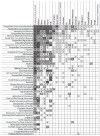Who Benefits from National Estuaries? Applying the FEGS Classification System to Identify Ecosystem Services and their Beneficiaries
- PMID: 31277218
- PMCID: PMC6651245
- DOI: 10.3390/ijerph16132351
Who Benefits from National Estuaries? Applying the FEGS Classification System to Identify Ecosystem Services and their Beneficiaries
Abstract
In spite of their perceived value, the widespread implementation of ecosystem services assessments has been limited because of perceptions of being too technical, too expensive, or requiring special expertise. For example, federal estuary management programs have widely used ecosystem services concepts to frame management issues and communicate with stakeholders. Yet, indicators assessed, monitored, and reported in estuarine management still have traditionally focused on ecological conditions, with weak connections, if any, to social or economic outcomes. Approaches are needed which expand the range of ecosystem services that can be considered, link ecosystem services explicitly to different stakeholder groups, facilitate effective communication with economists and other social scientists, and expand the array of available valuation techniques. We applied the concept of final ecosystem goods and services to review the broad suite of ecosystem services and their beneficiaries relevant to the management of two federal programs for estuary management, the National Estuary Program (NEP) and the National Estuarine Research Reserve System (NERRS). The Final Ecosystem Goods and Services Classification System provided a structured framework for connecting ecosystem services to their beneficiaries and the environments providing them. Document analysis of management plans assessed the degree to which these programs consider ecosystem services, their beneficiaries, and habitats within the estuarine watershed. The hierarchical list of final ecosystem goods and services generated from document analysis serves as a tool for defining management goals, identifying stakeholders, developing meaningful indicators, and conducting valuation studies in estuarine management planning efforts. Though developed here for estuarine management, the keyword hierarchy and final ecosystem goods and services approach have broad applicability and transferability to other environmental management scenarios.
Keywords: beneficiaries; document analysis; estuary management; final ecosystem goods and services.
Conflict of interest statement
The authors declare no conflict of interest.
Figures







Similar articles
-
Ecosystem Services Profiles for Communities Benefitting from Estuarine Habitats along the Massachusetts Coast, USA.Ecol Inform. 2023 Nov 1;77:1-20. doi: 10.1016/j.ecoinf.2023.102182. Ecol Inform. 2023. PMID: 38487338 Free PMC article.
-
The final ecosystem goods and services Voltron: the power of tools together.Front Ecol Evol. 2023 Dec 21;11:1-16. doi: 10.3389/fevo.2023.1290662. Front Ecol Evol. 2023. PMID: 38516293 Free PMC article.
-
Integrating management tools and concepts to develop an estuarine planning support system: A case study of the Humber Estuary, Eastern England.Mar Pollut Bull. 2015 Nov 15;100(1):393-405. doi: 10.1016/j.marpolbul.2015.08.017. Epub 2015 Sep 3. Mar Pollut Bull. 2015. PMID: 26342391
-
An operational model for mainstreaming ecosystem services for implementation.Proc Natl Acad Sci U S A. 2008 Jul 15;105(28):9483-8. doi: 10.1073/pnas.0706559105. Epub 2008 Jul 9. Proc Natl Acad Sci U S A. 2008. PMID: 18621695 Free PMC article. Review.
-
Identifying ecological production functions for use in ecosystem services-based environmental risk assessment of chemicals.Sci Total Environ. 2021 Oct 15;791:146409. doi: 10.1016/j.scitotenv.2021.146409. Epub 2021 Mar 13. Sci Total Environ. 2021. PMID: 33771395 Review.
Cited by
-
Connecting stakeholder priorities and desired environmental attributes for wetland restoration using ecosystem services and a heat map analysis for communications.Front Ecol Evol. 2024 Mar 27;12:1-15. doi: 10.3389/fevo.2024.1290090. Front Ecol Evol. 2024. PMID: 38628570 Free PMC article.
-
Ecosystem Services Profiles for Communities Benefitting from Estuarine Habitats along the Massachusetts Coast, USA.Ecol Inform. 2023 Nov 1;77:1-20. doi: 10.1016/j.ecoinf.2023.102182. Ecol Inform. 2023. PMID: 38487338 Free PMC article.
-
Synthesis of Two Decades of US EPA's Ecosystem Services Research to Inform Environmental, Community, and Sustainability Decision Making.Sustainability. 2021 Jul 23;13(15):1-8249. doi: 10.3390/su13158249. Sustainability. 2021. PMID: 34804601 Free PMC article.
-
Identifying priority ecosystem services in tidal wetland restoration.Front Ecol Evol. 2024 Jul 7;12:1-22. doi: 10.3389/fevo.2024.1260447. Front Ecol Evol. 2024. PMID: 39381718 Free PMC article.
-
Recreational beneficiaries and their landscape dependencies across national estuary program sites: Tillamook Bay (OR) and Tampa Bay (FL), USA.Ecosyst People (Abingdon). 2023 Nov 15;19(1):1-21. doi: 10.1080/26395916.2023.2276756. Ecosyst People (Abingdon). 2023. PMID: 38152719 Free PMC article.
References
-
- Millennium Ecosystem Assessment . Ecosystems and Human Well-Being: Synthesis. Island Press; Washington, DC, USA: 2005.
-
- Arkema K.K., Verutes G.M., Wood S.A., Clarke-Samuels C., Rosado S., Canto M., Rosenthal A., Ruckelshaus M., Guannel G., Toft J., et al. Embedding ecosystem services in coastal planning leads to better outcomes for people and nature. Proc. Natl. Acad. Sci. USA. 2015;112:7390–7395. doi: 10.1073/pnas.1406483112. - DOI - PMC - PubMed
-
- Olander L., Johnson R.J., Tallis H., Kagan J., Maguire L., Polasky S., Urban D.L., Boyd J., Wainger L.A., Palmer M. Best Practices for Integrating Ecosystem Services into Federal Decision Making: National Ecosystems Partnership. Duke University; Durham, NC, USA: 2015.
-
- Boyd J., Banzhaf S. What are ecosystem services? The need for standardized environmental accounting units. Ecol. Econ. 2007;63:616–626. doi: 10.1016/j.ecolecon.2007.01.002. - DOI
MeSH terms
LinkOut - more resources
Full Text Sources

